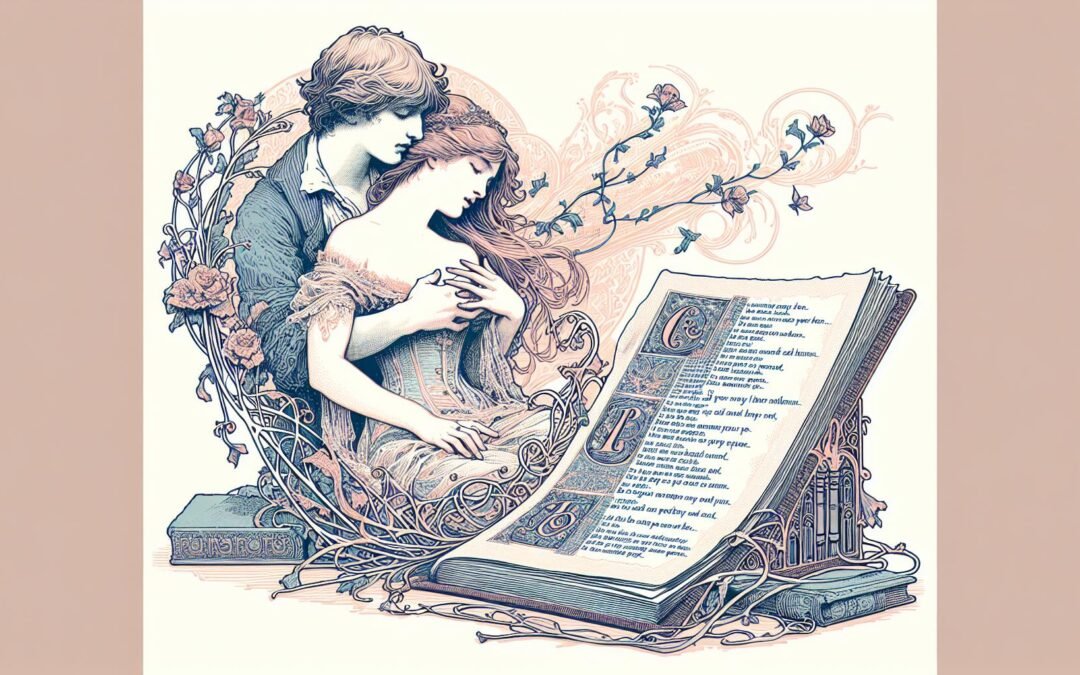I love you poems for her represent a living, global tradition, shaped through centuries of poetic imagination and linguistic invention. From the earliest fragments of lyric verse to postmodern experiments, these poems illuminate shifting ideals of devotion, longing, and identity. Sappho, Petrarch, Shakespeare, and contemporary poets all contribute to this lineage, using new forms to voice the enduring mysteries of love. Sentiments and motifs evolve, but the need to articulate this intimate confession remains constant. Early Greek lyric, Renaissance sonnets, Persian ghazals, and modern blank verse demonstrate the ways poets respond to culture and language, continually crafting new approaches. Leading collections of romantic verse showcase how this tradition remains vital, introducing new generations to historic voices and inspiring fresh expression.
Historical Foundations of I Love You Poems for Her
Before the concept acquired its current clarity, lyric poetry reflected desire in myriad forms. Sappho’s compact Aeolic Greek lines fused passion with religious invocation. Her pledges mix the tactile with the divine, as in entreaties to Aphrodite or phrases that entwine the beloved’s presence and ritual devotion. In Ancient Rome, Ovid uses the interplay of wit and feeling in the “Amores”, pivoting from longing to literary artifice. His work fixes love as an object of technique and pursuit, not only as sentiment. Troubadours in medieval southern France turned fealty into sophisticated verse, transforming courtly adoration into stylized longing. Meanwhile, Ovid’s techniques travel across centuries, influencing generations of poets who each adopt and adapt the tradition.
Transformations: Renaissance to Modernism
The Renaissance reimagined previous traditions through Petrarch’s sonnets for Laura. Petrarch features the unattainable beloved, exploring yearning and frustration through tightly wrought forms. Shakespeare, writing for the stage and page, blends personal introspection with inventive imagery. His sonnets play with established motifs, as in Sonnet 18, where he immortalizes affection through poetry itself. The Romantic era, marked by Byron, Keats, and Shelley, advances an individualistic and passionate approach, casting love as a struggle against transience. In “Sonnets from the Portuguese”, Elizabeth Barrett Browning reveals private emotion, linking spiritual aspiration and bodily desire in direct speech. Victorian poets such as Tennyson balance lush natural detail with narrative, while Christina Rossetti brings emotional subtlety into structured lyric. Influenced by H.D., E.E. Cummings and others, Modernist and contemporary poets break older forms to explore love’s uncertainty amid urban settings and fragmented realities.
Culture and Language
Poetic approaches to love vary greatly across regions. Persian poets expand the tradition with ghazals, harnessing Arabic and Farsi vocabularies in intricate patterns. Ghazals highlight repetition and lyric longing, embedding the beloved in a framework of ritual language. Japanese tanka present declarations within brief forms, pairing intense emotion with formal discipline and seasonal imagery. Praise poetry from African oral traditions brings communal values and metaphor into representations of love. Distinctive forms appear globally, as Chinese, Yoruba, and Zulu poetry each provide distinct strategies for naming and understanding affection. The role of language structure and social context becomes central, shaping not only content but also delivery, imagery, and audience engagement. Collections exploring these variations illustrate how universal confessions adopt unique local color.
Lexical and Structural Signatures
Writers select from a wide creative palette as they compose i love you poems for her. Lexical diversity remains a hallmark, with synonyms and endearments possessing their own resonance. Words like “adore” or “cherish” express shades of attachment, while private or familial endearments create intimacy. In many poems, metaphors replace direct statements. The beloved appears as a rose, a star, a source of illumination, or a cathedral of light. Sometimes inventiveness extends to coining new epithets. Historical and contemporary poems collected at repositories dedicated to poetic love reveal how such choices amplify uniqueness.
Imagery and Symbolism
Physical detail activates the senses: sight, sound, and touch. Shakespeare compares affection to “rough winds” and “summer’s lease”, transferring natural imagery directly to the experience of love. Barrett Browning narrows great distances to an embrace, using geography and metaphor to convey longing. Common motifs reappear as birds, rivers, gardens, and celestial objects, providing a symbolic vocabulary for connection and desire. Modern writers introduce urban imagery or references to technology, giving current poems a distinct setting. The beloved’s presence, conveyed through descriptions of eyes, laughter, or gesture, creates immediacy, while references to wisdom or compassion indicate reverence beyond the surface. Throughout history, poetic attention to time and impermanence reminds readers that intimacy seeks preservation against change and loss. Curated digital anthologies reveal how new motifs and language keep the tradition vibrant.
Syntax, Meter, and Register
Poets shape meaning through sentence and line structure. Petrarchan sonnets, for instance, depend on ordered rhyme and logical turns. Blank verse encourages directness, while modern and contemporary poems use fragmentation, enjambment, or variation in line length to disrupt expectation. In expressing passion, poets may favor brief, emphatic sentences that mimic the intensity of feeling. Register fluctuates from heightened, ceremonial diction to colloquial language. Poets including Rainer Maria Rilke create complexity through abstraction and classical reference, while others rely on simplicity for immediacy. Contemporary poems might shift between registers within a single piece, mixing slang with references from scripture or myth. This layering mirrors the complications of modern relationships and inner life. Resources focused on poetic form and voice demonstrate how meter, syntax, and diction interlock to create atmosphere and impact.
Themes and Global Patterns in “I Love You” Poems for Her
Recurring themes structure the expression of affection: devotion, admiration, longing, and loyalty. Poets articulate promises through invitations to remain close or face hardship together. Admiration appears in praise both of beauty and of character: intellect, courage, or unique gestures receive notice. When writing about separation, poets describe anticipation and the ache of distance. Loyalty refers not only to exclusivity but to emotional perseverance, explored within and across cultural frameworks. Critical anthologies trace how these themes circulate across time and place.
Nature, Time, and Individual Voice
Classical and modern poets alike use nature to express urgency and connection. Ancient writers compare beloveds to flowers and fawns, while contemporary voices choose new metaphors—skylines, city lights, digital signals—to ground desire in their historical moment. Physical description, whether of eyes, laughter, or movement, carries emotional significance. At various times, poets elevate character traits like honesty or wisdom, using spiritual or philosophical language. Tensions surrounding time and mortality persist, inspiring poetry that celebrates the fleeting or commemorates moments otherwise lost. The tradition supports both archetype and personal detail, so readers glimpse shared patterns and individual experience.
Intercultural Approaches and Translation
Traditions in Europe, Asia, Africa, and the Americas provide distinct literary blueprints. Western traditions, beginning with Petrarch and moving to Shakespeare and the metaphysical poets, sometimes rely on exaggerated metaphor. Eastern writing, from Tang Dynasty poets to waka masters, prizes restraint, allusion, and attention to seasonality or impermanence. Sufi mystics, especially Rumi and Hafez, express romantic love as a metaphor for spiritual yearning, collapsing boundaries between body and soul. Expression in French, Spanish, Arabic, Yoruba, and Chinese all carries unique implications due to idiom, tone, and cultural context. Translation brings challenges, since literal versions fail to capture nuance and resonance. When poems transition across languages, translators respond with creative adaptation to preserve poetic intent and emotional force. For readers wanting practical approaches and contemporary examples, new perspectives may be found at Plough.

